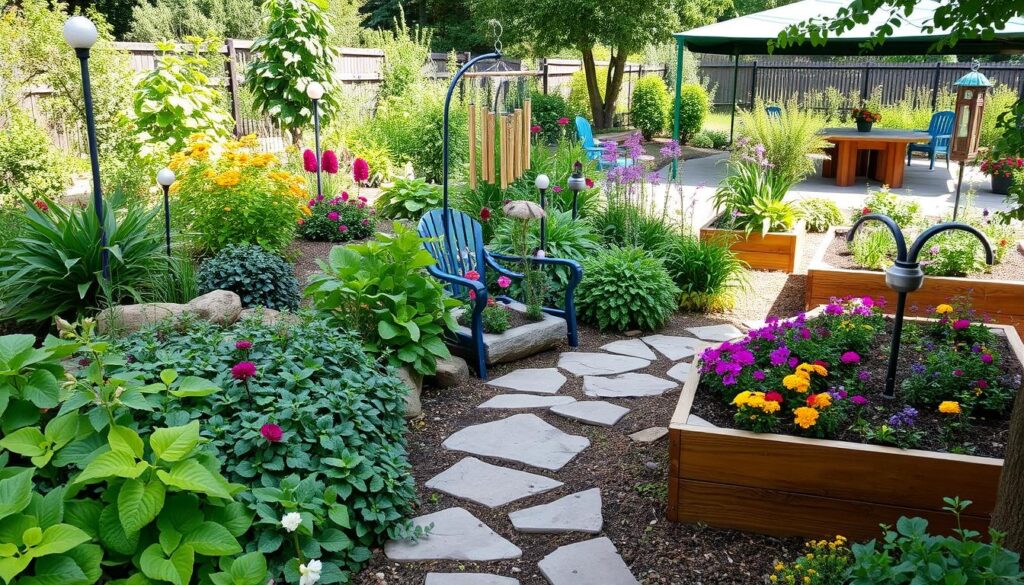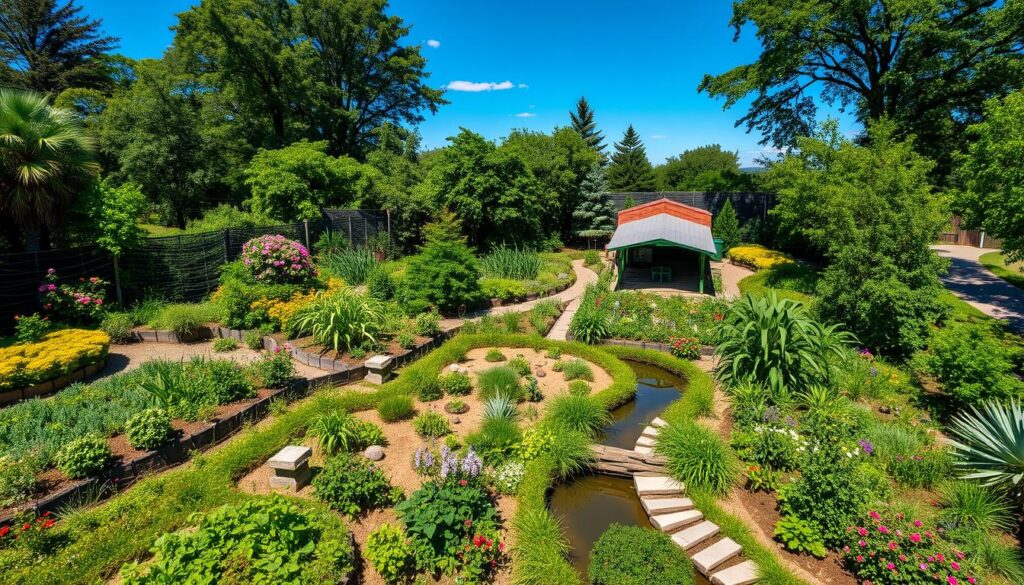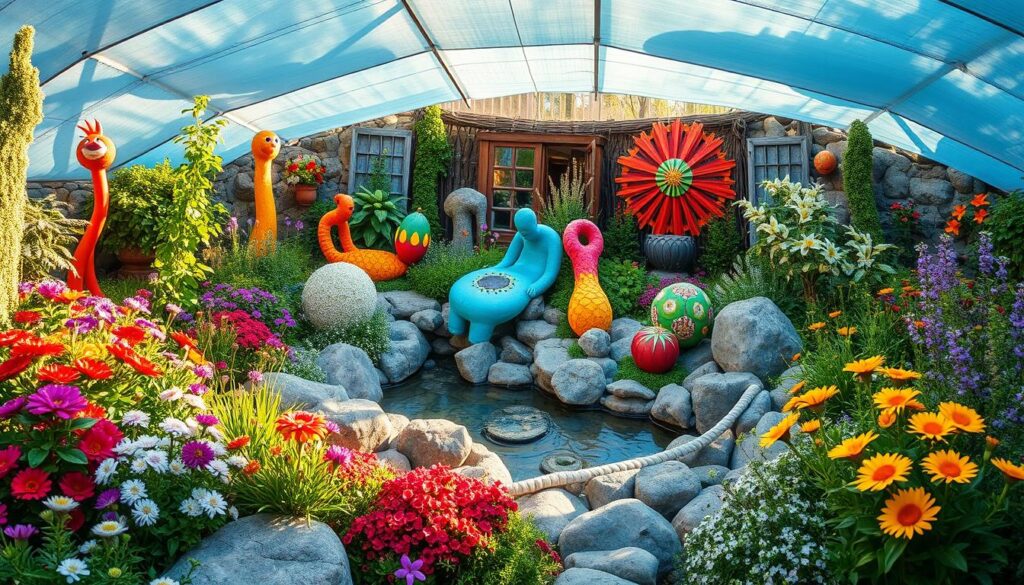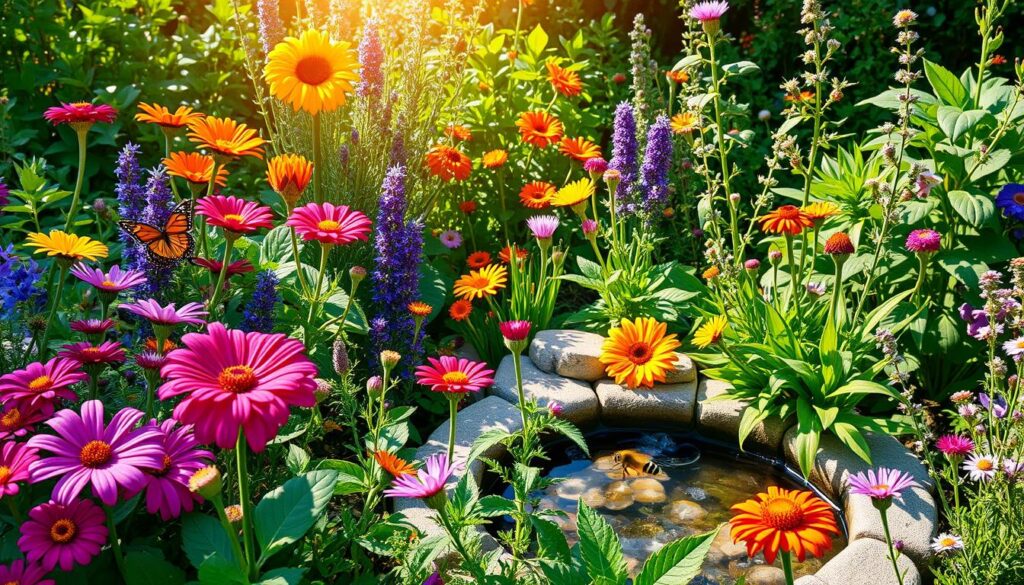The gentle rustling of leaves and the soft herbs between my fingers stirred something deep inside me. My journey into permaculture sensory gardens started with a simple wish. I wanted to reconnect with nature’s rhythms and healing power.
Sustainable gardening is more than growing plants. It’s about making living ecosystems that touch all our senses and care for the environment. By using permaculture, we can turn simple spaces into amazing sensory experiences. These experiences help both humans and nature feel better.
Picture a garden full of life, where every part has a purpose. Plants that need half the water, many species that attract pollinators, and designs that help local wildlife. This is what permaculture sensory gardens are all about.
Key Takeaways
- Sensory gardens create immersive nature experiences
- Permaculture principles support ecological sustainability
- Gardens can improve mental health and biodiversity
- Sustainable design reduces resource consumption
- Engaging multiple senses enhances garden interaction
Introduction to Permaculture Sensory Gardens
Permaculture is a new way to design sustainable ecosystems. It blends human needs with nature’s cycles. It started in Australia in the 1970s and changed how we see our environment.
What is Permaculture?
Permaculture is a design system that follows nature. Bill Mollison and David Holmgren created it. It aims to make environments that help both people and nature.
- Originated in Australia in 1975
- Emphasizes sustainable design principles
- Integrates human activities with natural systems
Understanding Sensory Gardens
Sensory gardens are special places that use nature to engage our senses. They help us relax, learn, and heal. These gardens are designed to be interactive and therapeutic.
| Sensory Garden Element | Engagement Purpose |
|---|---|
| Textured Plants | Touch Stimulation |
| Aromatic Herbs | Smell Experiences |
| Wind Chimes | Sound Connection |
Benefits of Combining Permaculture and Sensory Gardens
Permaculture and sensory gardens together create a unique environment. This environment supports both nature and human well-being. It’s not just beautiful but also functional and sustainable.
“Permaculture is about creating sustainable human habitats by following nature’s patterns.” – Bill Mollison
This approach lets gardeners build rich, diverse landscapes. These landscapes support biodiversity, save resources, and offer deep sensory experiences.
Key Elements of a Sensory Garden
Creating a sensory garden needs careful thought about how different elements affect our senses. Landscape architecture is key in making spaces that engage our senses. This turns ordinary gardens into special places.

Sensory integration is crucial in making these immersive outdoor spaces. Gardens are more than just pretty views. They are complex systems that interact with our senses.
Sight: Color and Texture
Visual elements are the base of sensory gardens. Choosing plants wisely can make landscapes that change with the seasons.
- Native grasses like Little bluestem change from powder blue to deep red
- Blanket flowers have fuzzy leaves that feel nice
- Different plant heights add depth and interest
Sound: Water and Wind Features
Horticulture therapy shows how important sound is in garden design. Sounds can lower stress and help us relax.
“A garden’s sound is as important as its visual beauty.”
- Ornamental grasses like Big bluestem move gently, making soft sounds
- Water features offer calming background noises
- Wind chimes add musical sounds
Smell: Aromatic Plants
Fragrant plants turn gardens into sensory experiences that touch deep emotions.
| Plant | Sensory Quality | Additional Benefits |
|---|---|---|
| Chocolate Flower | Chocolate-scented blooms | Attracts pollinators |
| Lavender | Calming fragrance | Stress reduction |
| Jasmine | Sweet nighttime scent | Mood enhancement |
Each sensory element adds to a complete garden experience. It supports both human well-being and nature’s balance.
Designing with Nature in Mind
Permaculture is a new way to design our environments. It teaches us to work with nature, not against it. This approach changes how we see landscapes.
Starting a sustainable garden needs careful planning. Landscape architecture shows us the importance of knowing a space well. This knowledge helps create healthy ecosystems.
Site Analysis and Strategic Planning
Permaculture experts suggest a detailed site analysis. This includes:
- Mapping sunlight patterns throughout the day
- Identifying natural water flow directions
- Assessing soil composition and drainage
- Evaluating existing vegetation and wildlife interactions
“Design with nature, not against it.” – Bill Mollison, Permaculture Pioneer
Selecting Appropriate Plant Species
Picking the right plants is key in ecological design. Native plants usually fit best in their local environment. They need little care and help local wildlife.
Creating Microclimates
Microclimates are special design techniques. They help plants grow better by using the land’s shape. Gardeners can make areas that protect plants and need less outside help.
The secret to a good sustainable garden is patience and respect for nature. It’s about observing and working with the environment.
The Role of Soil in Permaculture
Soil is the heart of any sustainable garden. In organic gardening, knowing about soil health is key to a thriving garden. Permaculture sees soil as a living system, full of tiny life forms.
Did you know? A single teaspoon of healthy soil can hold up to 1 billion organisms. This amazing diversity is what makes sustainable gardening work and helps plants grow strong.
Building Healthy Soil
To make nutrient-rich soil, we need smart strategies. Here are some:
- Minimizing soil disturbance
- Maintaining consistent organic matter coverage
- Promoting diverse microbial ecosystems
- Implementing regenerative practices
Composting Techniques
Composting turns waste into soil gold. There are many ways to compost, depending on your garden:
| Composting Method | Characteristics | Best For |
|---|---|---|
| Lasagna Method | Layer-based composting | Small urban gardens |
| Vermicomposting | Uses worms to break down materials | Indoor and compact spaces |
| Hot Composting | Rapid decomposition | Large garden spaces |
Soil Amendments
“Soil is the great connector of lives, the source and destination of all.” – Wendell Berry
Good soil amendments boost garden success. Organic stuff like compost and aged manure make plants happy. Research shows that fixing soil can up crop yields by 200%.
In sustainable gardening, we aim for a garden that looks after itself. By caring for the soil, we make gardens that are strong and productive, needing little help from outside.
Water Management Strategies
Water is essential for any garden, more so in landscape architecture. Sustainable gardening needs smart water use to save resources and help plants grow.

Good water-saving methods can really change how well a garden grows and stays healthy. Using smart water plans can cut water bills by 30-50%, which is big in dry areas.
Rainwater Harvesting Techniques
Rainwater harvesting is key in sustainable gardening. It lets gardeners:
- Use less city water
- Save on water costs
- Give plants clean water
Swales and Contour Landscaping
Swales are smart earthwork in permaculture. They help:
- Slow down water flow
- Stop soil erosion
- Help groundwater recharge
Efficient Drip Irrigation
Drip irrigation is top-notch for saving water in gardening. It sends water right to the roots, cutting down on waste.
“In permaculture, every drop of water is a resource to be cherished and strategically utilized.” – Permaculture Design Principle
| Water Management Method | Water Savings | Ecosystem Impact |
|---|---|---|
| Rainwater Harvesting | 30-50% | Positive |
| Swale Systems | 25-40% | Highly Positive |
| Drip Irrigation | 40-60% | Minimally Invasive |
Sustainable water management is more than saving water—it’s about making gardens that work well on their own.
Biodiversity and Plant Selection
Creating a vibrant sensory garden needs a deep understanding of biodiversity and choosing the right plants. Sustainable gardening focuses on building a rich, connected ecosystem. This supports local wildlife and boosts sensory experiences.
Organic gardening is key to a strong garden environment. The right plants can turn a simple garden into a thriving ecosystem. This supports both human enjoyment and ecological health.
Companion Planting Strategies
Companion planting is a powerful method in environmental design. It boosts garden productivity and health. Some great plant pairs include:
- Tomatoes with basil to improve flavor and repel pests
- Carrots alongside onions to deter carrot flies
- Strawberries planted near borage to enhance growth
Native vs. Non-Native Plant Considerations
Choosing the right plants is crucial for a successful sensory garden. Native plants have big advantages in sustainable gardening:
| Native Plants | Non-Native Plants |
|---|---|
| Require less water | May need more maintenance |
| Support local wildlife | Potential invasive risks |
| Adapted to local climate | Can introduce unique visual elements |
“A biodiverse garden is like a living symphony, where each plant plays a unique and essential role in the ecosystem’s harmony.” – Permaculture Design Expert
Studies show that gardens with more biodiversity are more resilient. Adding flowering perennials can quickly boost insect diversity, often seen in days.
By picking plants that work well together and support local ecosystems, gardeners can make sensory spaces. These spaces are not just beautiful but also ecologically significant.
Integrating Art and Nature
Landscape architecture turns sensory gardens into living art. Art and nature come together here. Visitors get to experience deep nature immersion in these spaces.

Art adds life to gardens, making them unique. Sculptures, installations, and paths make the garden more than just a place to be. They make it a place to explore and feel.
Sculptures and Installations
Art in landscape design does more than look good:
- Create focal points that draw the eye
- Provide tactile exploration opportunities
- Reflect local cultural or natural themes
- Encourage interaction with the environment
Pathways and Seating Areas
Paths in therapeutic landscapes need to be accessible and engaging. The material and design of paths are key to a good experience.
| Path Material | Sensory Experience | Accessibility |
|---|---|---|
| Gravel | Crunchy sound, varied texture | Moderate wheelchair access |
| Wood Chips | Soft, natural feel | Limited wheelchair access |
| Smooth Concrete | Uniform surface | Excellent wheelchair accessibility |
“In a well-designed sensory garden, every path tells a story, and every seating area invites reflection.” – Landscape Design Experts
Seating areas in gardens offer a chance to rest and think. Ergonomic design ensures comfort while maintaining aesthetic harmony with the landscape.
Maintaining Your Sensory Garden
To keep your sensory garden alive, you need to use organic and sustainable gardening methods. It’s not just about keeping things the same. It’s about making your garden a living space that touches all your senses and keeps nature in balance.
Good garden care means taking care of it all year round and keeping pests away naturally. Gardening can be good for your mind and teach you new things, says horticulture therapy.
Seasonal Care Tasks
Your sensory garden needs special care all year:
- Spring: Prune plants and get the soil ready
- Summer: Keep plants watered and use mulch
- Fall: Plant bulbs and protect plants from cold
- Winter: Keep roots safe and plan for next year
Natural Pest Control Methods
Using green gardening ways helps fight pests without chemicals:
- Attract good bugs like ladybugs
- Plant things together that help each other
- Make your garden diverse
- Use natural pest stoppers
“Long and careful observation can save you from rash actions in garden management.”
By sticking to organic gardening, your sensory garden becomes a strong, self-healing place. It’s a place that excites your senses and keeps nature in balance.
Engaging the Five Senses
Sensory integration turns gardens into places that deeply engage our senses. These spaces are more than just pretty views. They are interactive environments that connect us with nature through touch, taste, and more.

Gardens are great for horticulture therapy because they let us explore with our senses. By understanding how plants affect us, we can form deep bonds with nature.
Exploring Tactile Experiences
Touch is a key way we interact with gardens. Plants with different textures invite us to explore:
- Soft, fuzzy lamb’s ear leaves
- Rough tree bark surfaces
- Smooth succulent leaves
- Spiky ornamental grasses
Delicious Garden Flavors
Edible plants make gardens into places where we can taste and learn. Growing herbs and fruits offers a feast for the senses:
- Aromatic herbs like basil and mint
- Sweet berries such as strawberries
- Fresh vegetables with unique textures
| Sensory Category | Plant Examples | Interaction |
|---|---|---|
| Touch | Lamb’s Ear | Soft, velvety texture |
| Taste | Mint | Fresh, cooling flavor |
| Smell | Lavender | Calming aromatic experience |
Combining Sensory Dimensions
To create a full sensory experience, choose plants carefully. Mix plants that offer many sensory experiences. This turns gardens into living, breathing spaces that engage and heal us.
A garden is a profound teacher of patience, connection, and sensory awareness.
Community Involvement in Garden Design
Creating vibrant sensory gardens is more than just planting and design. It’s about bringing communities together. Together, we can turn green spaces into living, breathing ecosystems of learning and connection.
Cultivating Community Engagement
Environmental design flourishes when locals get involved. Nature immersion programs can turn ordinary spaces into amazing community resources. Horticulture therapy lets people of all ages connect with nature and each other.
Workshops and Educational Programs
- Develop hands-on permaculture workshops
- Create age-appropriate gardening classes
- Design interactive learning experiences
- Host seasonal gardening seminars
“When children find joy in the garden, the seeds for a lifelong love of permaculture are sown.”
Volunteering Opportunities
Community gardens are great for shared learning and personal growth. They become dynamic spaces of education, healing, and ecological awareness through volunteer efforts.
- Recruit local volunteers of all skill levels
- Create inclusive gardening programs
- Develop mentorship opportunities
- Establish skill-sharing networks
Research shows the power of community gardens. They can:
- Reduce depression rates by 60%
- Lower gun violence by 20%
- Improve community connections
- Enhance local biodiversity
Community involvement is more than gardening. It’s about growing stronger, more connected neighborhoods.
Overcoming Challenges in Sensory Gardens
Sustainable gardening needs careful planning and the ability to bounce back. Sensory gardens have special challenges that call for creative solutions. Knowing these issues helps gardeners make stronger and flexible outdoor areas.
Navigating Pest Management in Organic Gardening
Organic gardening offers natural ways to fight pests. Gardeners can try several methods:
- Companion planting to keep harmful insects away
- Introducing beneficial predatory insects
- Using natural pest repellents
- Maintaining diverse plant ecosystems
Climate Adaptation Strategies
Climate change is a big problem for sensory gardens. But, there are ways to adapt:
| Challenge | Adaptation Strategy |
|---|---|
| Extreme Temperature Fluctuations | Selecting resilient native plant species |
| Reduced Precipitation | Implementing water-efficient irrigation systems |
| Increased Pest Pressure | Developing diverse micro-ecosystems |
“Resilience in gardening means working with environmental changes, not against them.” – Ecological Design Experts
By using sustainable gardening, gardeners can make sensory spaces that are both lovely and flexible. With proactive planning and a focus on the environment, gardens can stay lively even when things change.
Success Stories of Sensory Gardens
Therapeutic landscapes are changing lives across the United States. They show how nature and gardening can heal and connect us. These gardens prove that people and nature can form deep bonds.
The Old Schoolhouse Community Garden: A Remarkable Case Study
The Old Schoolhouse Community Garden started in 2015. It’s a prime example of community effort in permaculture. This garden sits on a historic 40-acre land and shines as a model of sustainable farming and community building.
- Produced 800 lbs of surplus harvest annually
- Received a $2,500 tool grant from Fiskars
- Developed a comprehensive permaculture design plan
Impact and Community Benefits
The garden’s success goes beyond just growing food. It uses gardening therapy to help with education, health, and the environment. This makes it a special place for everyone.
“Our sensory garden is more than just a growing space—it’s a healing environment that connects people with nature.” – OSCG Project Director
Therapeutic Outcomes
Studies show the big benefits of sensory gardens:
- 60% of dementia patients show memory improvement
- 75% of caregivers report mood enhancement for patients
- 40% reduction in anxiety for individuals with special needs
These stories show how gardens can heal, bring people together, and connect us with nature. They inspire us to create more spaces like this.
Resources for Further Learning
Exploring permaculture sensory gardens is a journey that never ends. It’s about learning and connecting with others. This path is full of chances to grow and make new friends.
Finding the right resources can change how you see sensory gardens and permaculture. Knowing a lot is key to making beautiful, green spaces.
Essential Books for Deeper Understanding
- Permaculture: A Designer’s Manual by Bill Mollison
- Gaia’s Garden by Toby Hemenway
- The Sensory Garden by Beth Chatto
Online Learning Platforms
| Website | Focus Area | Resources |
|---|---|---|
| Permaculture Design Magazine | Sustainable Design | Online Courses |
| Regenerative Agriculture Academy | Environmental Design | Video Tutorials |
| Udemy Permaculture Courses | Practical Skills | Comprehensive Training |
Connecting with Local Permaculture Groups
Local permaculture groups offer hands-on learning. They have community gardens, workshops, and projects. These give you real-world insights into green gardening.
“Community is the cornerstone of permaculture learning” – Permaculture Design Principle
Additional Learning Opportunities
- Attend local gardening workshops
- Join online permaculture forums
- Participate in community garden projects
- Follow permaculture experts on social media
Learning more about permaculture sensory gardens can lead to big changes. It opens doors to better environmental design and gardening.
Conclusion: The Impact of Sensory Gardens
Sensory gardens are where therapy meets gardening. They’re not just pretty; they’re places where we can dive into nature. Studies show they help our mental health, lower stress, and connect us with nature.
These gardens do more than help us feel better. They use permaculture to help local wildlife and teach us about nature. Community gardens also bring people together, making us all care more about the planet.
Enhancing Wellbeing and Connection
Sensory gardens help us heal and grow in a big way. They use plants and water to calm us down and help us think clearly. They also help us feel connected to others and to nature.
Promoting Sustainability
As our planet faces big problems, sensory gardens show us a way forward. They show how design can make spaces that are good for both people and the planet. By following these ideas, we can change how we see nature, one garden at a time.

